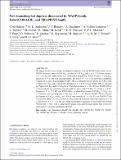Files in this item
New transiting hot Jupiters discovered by WASP-South, Euler/CORALIE, and TRAPPIST-South
Item metadata
| dc.contributor.author | Hellier, Coel | |
| dc.contributor.author | Andrerson, D. R. | |
| dc.contributor.author | Bouchy, F. | |
| dc.contributor.author | Burdanov, A. | |
| dc.contributor.author | Cameron, A. Collier | |
| dc.contributor.author | Delrez, L. | |
| dc.contributor.author | Gillon, M. | |
| dc.contributor.author | Jehin, E. | |
| dc.contributor.author | Lendl, M. | |
| dc.contributor.author | Nielsen, L. D. | |
| dc.contributor.author | Maxted, P. F. L. | |
| dc.contributor.author | Pepe, F. | |
| dc.contributor.author | Pollacco, D. | |
| dc.contributor.author | Queloz, D. | |
| dc.contributor.author | Ségransan, D. | |
| dc.contributor.author | Smalley, B. | |
| dc.contributor.author | Triaud, A. H. M. J. | |
| dc.contributor.author | Udry, S. | |
| dc.contributor.author | West, R. G. | |
| dc.date.accessioned | 2018-11-27T09:30:07Z | |
| dc.date.available | 2018-11-27T09:30:07Z | |
| dc.date.issued | 2019-01-01 | |
| dc.identifier | 256706912 | |
| dc.identifier | bbe5f6cd-5557-49ce-b2e5-7a6c7348a785 | |
| dc.identifier | 85057207860 | |
| dc.identifier | 000454575300096 | |
| dc.identifier.citation | Hellier , C , Andrerson , D R , Bouchy , F , Burdanov , A , Cameron , A C , Delrez , L , Gillon , M , Jehin , E , Lendl , M , Nielsen , L D , Maxted , P F L , Pepe , F , Pollacco , D , Queloz , D , Ségransan , D , Smalley , B , Triaud , A H M J , Udry , S & West , R G 2019 , ' New transiting hot Jupiters discovered by WASP-South, Euler/CORALIE, and TRAPPIST-South ' , Monthly Notices of the Royal Astronomical Society , vol. 482 , no. 1 , pp. 1379-1391 . https://doi.org/10.1093/mnras/sty2741 | en |
| dc.identifier.issn | 0035-8711 | |
| dc.identifier.other | BibCode: 2019MNRAS.482.1379H | |
| dc.identifier.other | ORCID: /0000-0002-8863-7828/work/58531322 | |
| dc.identifier.uri | https://hdl.handle.net/10023/16556 | |
| dc.description | Funding for WASP comes from consortium universities and from the UK’s Science and Technology Facilities Council. The Euler Swiss telescope is supported by the Swiss National Science Foundation. TRAPPIST-South is funded by the Belgian Fund for Scientific Research (Fond National de la Recherche Scientifique, FNRS) under the grant FRFC 2.5.594.09.F, with the participation of the Swiss National Science Fundation (SNF).The research leading to these results has received funding from the ARC grant for Concerted Research Actions, financed by the Wallonia-Brussels Federation. MG and EJ are, respectively, Research Associate and Senior Research Associate at the FNRS-F.R.S. LD acknowledges support from a Gruber Foundation Fellowship. | en |
| dc.description.abstract | We report the discovery of eight hot-Jupiter exoplanets from the WASP-South transit survey. WASP-144b has a mass of 0.44 MJup, a radius of 0.85 RJup, and is in a 2.27-d orbit around a V = 12.9, K2 star which shows a 21-d rotational modulation. WASP-145Ab is a 0.89 MJup planet in a 1.77-d orbit with a grazing transit. The host is a V = 11.5, K2 star with a companion 5 arcsec away and 1.4 mag fainter. WASP-158b is a relatively massive planet at 2.8 MJup with a radius of 1.1 RJup and a 3.66-d orbit. It transits a V = 12.1, F6 star. WASP-159b is a bloated hot Jupiter (1.4 RJup and 0.55 MJup) in a 3.8-d orbit around a V = 12.9, F9 star. WASP-162b is a massive planet in a relatively long and highly eccentric orbit (5.2 MJup, P = 9.6 d, e = 0.43). It transits a V = 12.2, K0 star. WASP-168b is a bloated hot Jupiter (0.42 MJup; 1.5 RJup) in a 4.15-d orbit with a grazing transit. The host is a V = 12.1, F9 star. WASP-172b is a bloated hot Jupiter (0.5 MJup; 1.6 RJup) in a 5.48-d orbit around a V = 11.0, F1 star. WASP-173Ab is a massive planet (3.7 MJup) with a 1.2 RJup radius in a circular orbit with a period of 1.39 d. The host is a V = 11.3, G3 star, being the brighter component of the double-star system WDS23366 − 3437, with a companion 6 arcsec away and 0.8 mag fainter. One of the two stars shows a rotational modulation of 7.9 d. | |
| dc.format.extent | 13 | |
| dc.format.extent | 2273611 | |
| dc.language.iso | eng | |
| dc.relation.ispartof | Monthly Notices of the Royal Astronomical Society | en |
| dc.subject | Stars: individual (WASP-144, WASP-145A, WASP-158, WASP-159, WASP-162, WASP-168, WASP-172, WASP-173A) | en |
| dc.subject | Planetary systems | en |
| dc.subject | QB Astronomy | en |
| dc.subject | NDAS | en |
| dc.subject.lcc | QB | en |
| dc.title | New transiting hot Jupiters discovered by WASP-South, Euler/CORALIE, and TRAPPIST-South | en |
| dc.type | Journal article | en |
| dc.contributor.sponsor | Science & Technology Facilities Council | en |
| dc.contributor.sponsor | Science & Technology Facilities Council | en |
| dc.contributor.sponsor | Science & Technology Facilities Council | en |
| dc.contributor.institution | University of St Andrews. School of Physics and Astronomy | en |
| dc.contributor.institution | University of St Andrews. St Andrews Centre for Exoplanet Science | en |
| dc.identifier.doi | 10.1093/mnras/sty2741 | |
| dc.description.status | Peer reviewed | en |
| dc.identifier.url | http://adsabs.harvard.edu/abs/2019MNRAS.482.1379H | en |
| dc.identifier.grantnumber | ST/M001296/1 | en |
| dc.identifier.grantnumber | ST/R00824/1 | en |
| dc.identifier.grantnumber | ST/R003203/1 | en |
This item appears in the following Collection(s)
Items in the St Andrews Research Repository are protected by copyright, with all rights reserved, unless otherwise indicated.

